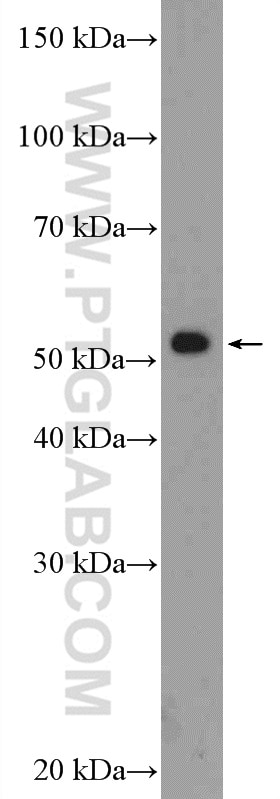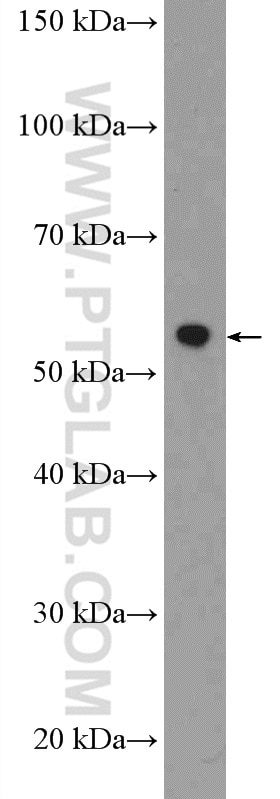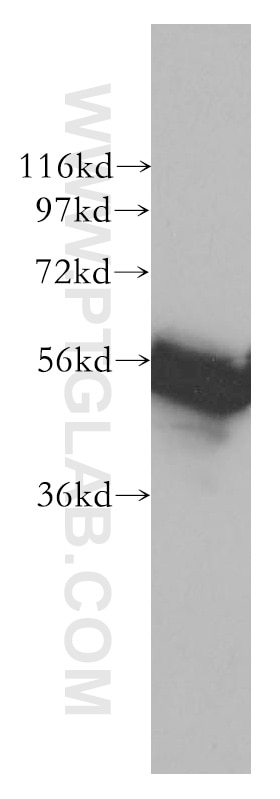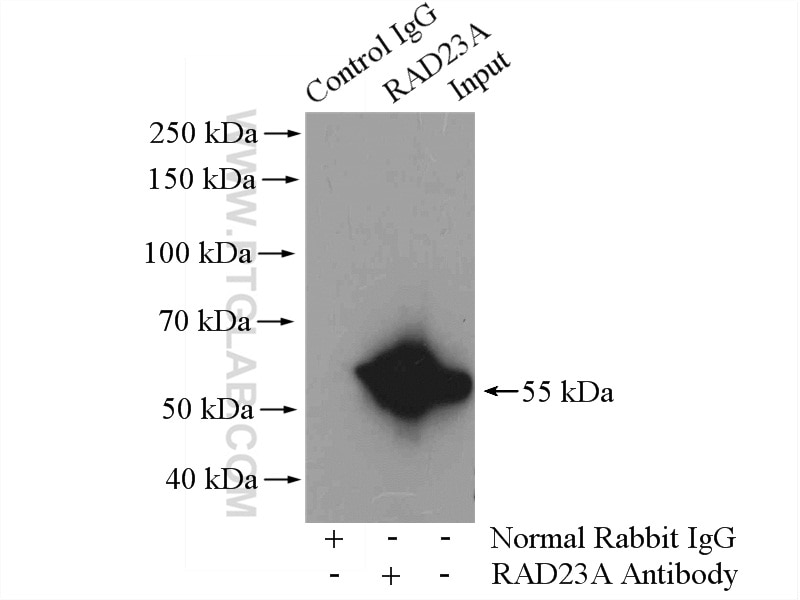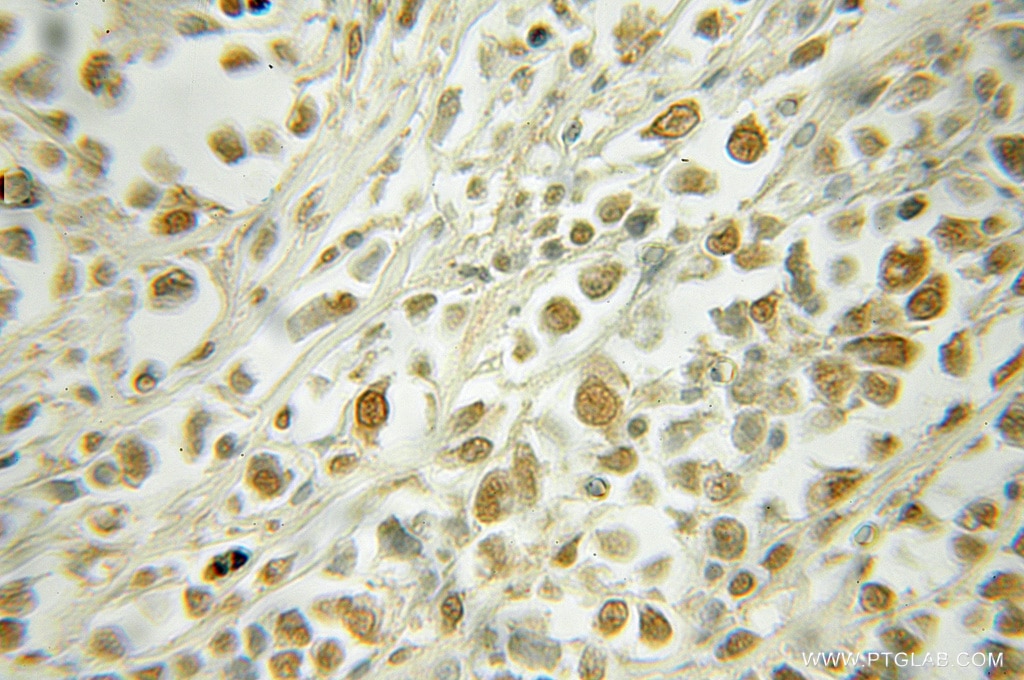Anticorps Polyclonal de lapin anti-RAD23A
RAD23A Polyclonal Antibody for IHC, IP, WB,ELISA
Hôte / Isotype
Lapin / IgG
Réactivité testée
Humain, rat, souris et plus (1)
Applications
WB, IP, IHC, IF, ELISA
Conjugaison
Non conjugué
N° de cat : 51033-1-AP
Synonymes
Galerie de données de validation
Applications testées
| Résultats positifs en WB | tissu splénique de souris, cellules Jurkat, tissu splénique de rat |
| Résultats positifs en IP | cellules Jurkat |
| Résultats positifs en IHC | tissu de lymphome humain il est suggéré de démasquer l'antigène avec un tampon de TE buffer pH 9.0; (*) À défaut, 'le démasquage de l'antigène peut être 'effectué avec un tampon citrate pH 6,0. |
Dilution recommandée
| Application | Dilution |
|---|---|
| Western Blot (WB) | WB : 1:500-1:2000 |
| Immunoprécipitation (IP) | IP : 0.5-4.0 ug for 1.0-3.0 mg of total protein lysate |
| Immunohistochimie (IHC) | IHC : 1:20-1:200 |
| It is recommended that this reagent should be titrated in each testing system to obtain optimal results. | |
| Sample-dependent, check data in validation data gallery | |
Applications publiées
| WB | See 3 publications below |
| IF | See 1 publications below |
Informations sur le produit
51033-1-AP cible RAD23A dans les applications de WB, IP, IHC, IF, ELISA et montre une réactivité avec des échantillons Humain, rat, souris
| Réactivité | Humain, rat, souris |
| Réactivité citée | Humain, singe, souris |
| Hôte / Isotype | Lapin / IgG |
| Clonalité | Polyclonal |
| Type | Anticorps |
| Immunogène | RAD23A Protéine recombinante Ag0716 |
| Nom complet | RAD23 homolog A (S. cerevisiae) |
| Masse moléculaire calculée | 40 kDa |
| Poids moléculaire observé | 55 kDa |
| Numéro d’acquisition GenBank | BC014026 |
| Symbole du gène | RAD23A |
| Identification du gène (NCBI) | 5886 |
| Conjugaison | Non conjugué |
| Forme | Liquide |
| Méthode de purification | Purification par affinité contre l'antigène |
| Tampon de stockage | PBS avec azoture de sodium à 0,02 % et glycérol à 50 % pH 7,3 |
| Conditions de stockage | Stocker à -20 ℃. L'aliquotage n'est pas nécessaire pour le stockage à -20oC Les 20ul contiennent 0,1% de BSA. |
Informations générales
RAD23A, also named as HHR23A, belongs to the RAD23 family. It is a multiubiquitin chain receptor involved in modulation of proteasomal degradation. RAD23A binds to 'Lys-48'-linked polyubiquitin chains in a length-dependent manner and with a lower affinity to 'Lys-63'-linked polyubiquitin chains. It is proposed to be capable to bind simultaneously to the 26S proteasome and to polyubiquitinated substrates and to deliver ubiquitinated proteins to the proteasome. It is involved in nucleotide excision repair and is thought to be functional equivalent for RAD23B in global genome nucleotide excision repair (GG-NER) by association with XPC. In vitro, the XPC:RAD23A dimer has NER activity. Can stabilize XPC. It is also involved in vpr-dependent replication of HIV-1 in non-proliferating cells and primary macrophages and is required for the association of HIV-1 vpr with the host proteasome. This antibody is a rabbit polyclonal antibody raised against a fusion protein of full length human RAD23A.
Protocole
| Product Specific Protocols | |
|---|---|
| WB protocol for RAD23A antibody 51033-1-AP | Download protocol |
| IHC protocol for RAD23A antibody 51033-1-AP | Download protocol |
| IP protocol for RAD23A antibody 51033-1-AP | Download protocol |
| Standard Protocols | |
|---|---|
| Click here to view our Standard Protocols |
Publications
| Species | Application | Title |
|---|---|---|
Front Immunol PDLIM7 Synergizes With PDLIM2 and p62/Sqstm1 to Inhibit Inflammatory Signaling by Promoting Degradation of the p65 Subunit of NF-κB. | ||
Cell Rep Autism-linked UBE3A gain-of-function mutation causes interneuron and behavioral phenotypes when inherited maternally or paternally in mice |
